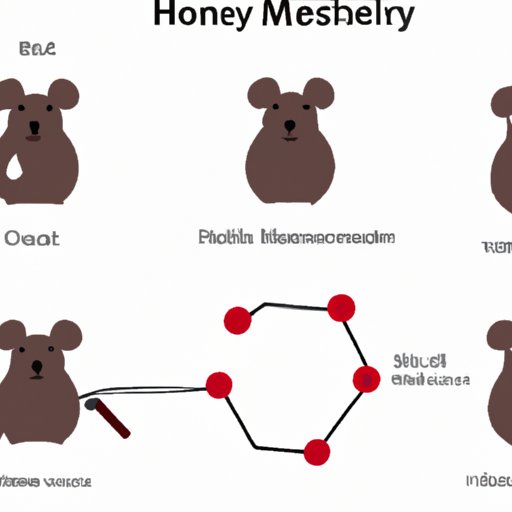Introduction
If you have encountered chemistry at any level, you have probably come across the concept of moles. But what exactly is a mole, and why is it important to understand it? In this article, we will explore the world of mole chemistry, from its definition to its role in predicting chemical reactions. Whether you are a beginner or an advanced student of chemistry, this comprehensive guide will provide you with everything you need to know about moles in chemistry.

Everything You Need to Know About Moles in Chemistry
A mole is simply a unit of measurement in chemistry that is used to express the amount of a substance. One mole of a substance is defined as the amount of that substance that contains the same number of particles as there are atoms in exactly 12 grams of carbon-12. This number, known as Avogadro’s number, is approximately 6.02 x 10^23 particles.
Chemists use moles to make sense of the vast numbers of particles that are involved in chemical reactions. By expressing the amount of a substance in terms of moles, chemists can make accurate predictions about how much of that substance will react in a given reaction. Additionally, moles help chemists compare the quantities of different substances that are involved in a reaction.
To calculate the number of moles in a given substance, you can use its molecular weight and the mass of the substance. For example, the molecular weight of water is approximately 18 grams per mole. If you have 36 grams of water, you can calculate the number of moles by dividing the mass by the molecular weight: 36 g ÷ 18 g/mol = 2 moles of water.
The Importance of Understanding Moles for Chemistry Students
For students of chemistry, understanding moles is a crucial part of mastering the subject. By developing a strong grasp of mole concepts, students can better understand the underlying principles of chemical reactions and how they relate to real-world applications.
Moles are especially important in stoichiometry, which is the study of the quantitative relationships between the reactants and products in a chemical reaction. In order to perform stoichiometry calculations, students must be able to convert between mass, moles, and particles of different substances. By developing these skills, students can calculate reactant and product quantities, theoretical yield, and percent yield for any given chemical reaction.
Additionally, moles are important for understanding chemical reactions in general. By knowing how many particles are involved in a reaction, chemists can better predict the outcome of that reaction. They can also determine the limiting reagent, which is the substance that gets consumed in the reaction and therefore limits the amount of product that can be produced.
Moles: The Building Blocks of Chemistry
Moles are considered a fundamental concept in chemistry, and for good reason. They serve as the building blocks for many important chemistry concepts, such as the mole concept, stoichiometry, and the ideal gas law.
The mole concept is based on Avogadro’s law, which states that equal volumes of gases at the same temperature and pressure contain equal numbers of particles. This law helps chemists relate volume to the number of particles in a sample, which is essential for understanding gas behavior.
Stoichiometry, as previously mentioned, uses moles as a key unit of measurement to determine the amounts of reactants and products in a chemical reaction. By understanding the mole concept, students can better visualize the relative quantities of particles involved in a reaction.
The ideal gas law combines the concepts of moles, gases, and pressure to describe the behavior of ideal gases. By using the terms “moles” and “particles” in the law, chemists can describe the behavior of gases in terms of the number of particles present rather than just their volume or pressure.
A Beginner’s Guide to Moles in Chemistry
For those who are new to chemistry, the concept of moles may seem overwhelming at first. However, by breaking it down into its basic concepts, you can get a better understanding of what it is and how it works.
First, it is important to remember that a mole is simply a unit of measurement. Just as you might measure something in inches or centimeters, chemists measure the amount of a substance in moles.
Second, you should understand how to calculate the number of moles in a substance. To do this, you need to know the molecular weight of the substance and the mass of the sample. Then, use the formula: moles = mass ÷ molecular weight.
Third, you should be able to convert between mass, moles, and particles for any given substance. For example, if you have 2 moles of water, you know that it contains approximately 1.2 x 10^24 particles.
The Role of Moles in Chemical Reactions
One of the primary reasons chemists use moles is to predict the outcomes of chemical reactions. By knowing the amount of each substance that is involved in a reaction, chemists can make accurate predictions about how much product will be produced and how much of each reactant will be consumed.
Moles are also important in determining the limiting reagent, as previously mentioned. The limiting reagent is the substance that gets consumed first and therefore limits the amount of product that can be produced. By knowing the number of moles of each substance that is involved in a reaction, chemists can determine which substance is the limiting reagent and make accurate predictions about the amount of product that can be produced.
Mole ratios are another important concept in chemical reactions. By comparing the ratios of moles of different substances involved in a reaction, chemists can predict how the reaction will proceed. For example, if the ratio of moles of reactant A to reactant B is 2:1, we know that A is being consumed at twice the rate of B, and we can make predictions about the products that will be formed.
Unpacking the Concept of Moles in Chemistry
Despite its importance, the concept of moles can be difficult to grasp. There are several common misconceptions that students have about moles that can lead to errors in calculations and misunderstandings of chemical reactions.
One common misconception is that moles are a measure of weight. While it is true that the number of moles of a substance is proportional to its mass, they are two different concepts. Moles are a measure of the number of particles present, while weight is a measure of the force of gravity acting on an object.
Another common error is mixing up the units of mass and weight. Mass is the amount of matter that an object contains, while weight is the force of gravity acting on that object. Since weight varies depending on the gravitational force, chemists use mass instead of weight when measuring the amount of a substance.
How Moles Help Chemists Measure and Predict Reactions
In addition to being crucial for understanding chemical reactions, moles also play a key role in laboratory settings. By accurately measuring the amount of reactants and products involved in a reaction, chemists can ensure that their experiments are reproducible and yield accurate results.
Mole calculations are used to prepare solutions of known concentration, which are used in a wide range of chemical experiments. By knowing the number of moles of a substance in a solution, chemists can accurately measure out the amount of that substance needed for the experiment.
Additionally, mole calculations are used to predict reaction outcomes. By knowing the number of moles of each substance involved in a reaction, chemists can predict the yield of that reaction and determine if it is feasible. They can also make predictions about the amount of product that will be formed and the amount of waste that will be generated.
Conclusion
Moled are a fundamental concept in chemistry that play a crucial role in predicting chemical reactions and understanding the quantitative relationships between substances. Whether you are a beginner or an advanced student of chemistry, understanding moles is essential for mastering the subject and developing a strong foundation for future study. By using the basic concepts and formulas outlined in this guide, you can better visualize the world of mole chemistry and its importance in real-world applications.
